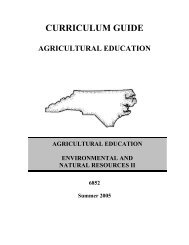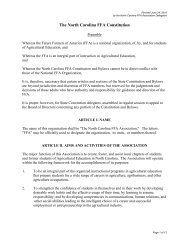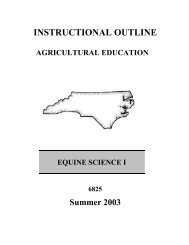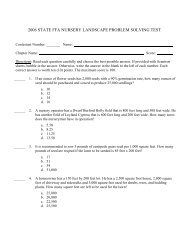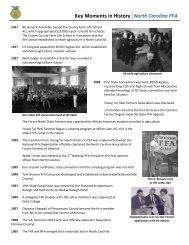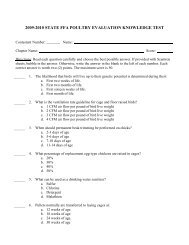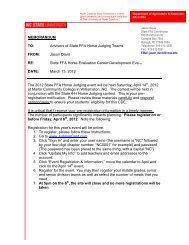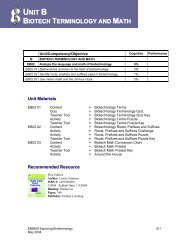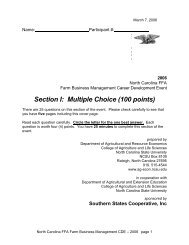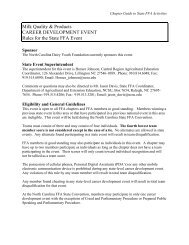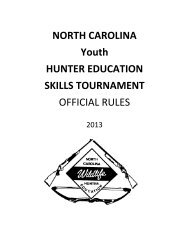Agricultural Education and FFA History North Carolina FFA - NC FFA
Agricultural Education and FFA History North Carolina FFA - NC FFA
Agricultural Education and FFA History North Carolina FFA - NC FFA
Create successful ePaper yourself
Turn your PDF publications into a flip-book with our unique Google optimized e-Paper software.
<strong>Agricultural</strong> <strong>Education</strong> <strong>and</strong> <strong>FFA</strong> <strong>History</strong> <strong>North</strong> <strong>Carolina</strong> <strong>FFA</strong><br />
The beginning of <strong>Agricultural</strong> <strong>Education</strong> in <strong>North</strong> <strong>Carolina</strong> Public Schools can be trace to the 1911<br />
General Assembly which passed the County Farm Life School Act. This act appropriated $25,000 a year<br />
to establish one such school in ten selected<br />
counties. The Craven County Farm Life School in<br />
Vanceboro was the first school established to<br />
teach agriculture in <strong>North</strong> <strong>Carolina</strong>. In 1917, the<br />
U.S. Congress passed the Smith-Hughes Act<br />
which provided federal funds for teaching<br />
Agriculture <strong>and</strong> Home Economics in public<br />
secondary schools. Agriculture courses were<br />
quickly added to the curriculum of many high<br />
schools throughout the state.<br />
The Early Beginnings<br />
An early agriculture classroom<br />
As early as 1920, interest in judging livestock was<br />
high among vocational agriculture students. During this year, 76 boys from 16 schools competed in a<br />
judging contest. Agriculture teachers <strong>and</strong> state leaders in <strong>North</strong> <strong>Carolina</strong> began to realize a need for a<br />
formal organization for students enrolled in agriculture courses. During the annual <strong>North</strong> <strong>Carolina</strong><br />
agriculture teachers’ conference, Walter Newman, State Supervisor of Agriculture <strong>Education</strong> in Virginia<br />
talked to teachers about the success of a boy’s club begun in there. Tom E. Browne, <strong>North</strong> <strong>Carolina</strong><br />
State Director of Vocational <strong>Education</strong> (1918-1946), began to support the introduction of a club for boys<br />
of agricultural education in the state <strong>and</strong> with the help of Roy Thomas, State Director for Vocational<br />
Agriculture <strong>and</strong> A.T. Allen, State Superintendent of Public Instruction, work was begun to establish such<br />
a club. The club, known as the Young Tar Heel Farmers was incorporated in the fall of 1927 under the<br />
laws of the State of <strong>North</strong> <strong>Carolina</strong>. These individuals were instrumental in guiding the YTHF <strong>and</strong> <strong>FFA</strong> in<br />
the early years.<br />
On Wednesday, June 20, 1928, 300 delegates of vocational agriculture students representing 110 rural<br />
high schools from 66 counties attended meetings at <strong>NC</strong> State University (then State College). The first<br />
meeting was held Wednesday evening in Pullen Hall, where Dr. Clarence Poe, Editor of Progressive<br />
Farmer was the principal speaker. The Young Tar Heel Farmer B<strong>and</strong> of Garner <strong>and</strong> Apex supplied the<br />
music for the night. The next day a dairy judging<br />
contest was held <strong>and</strong> the top four scoring<br />
individuals composed the team to judge in the<br />
national Dairy Judging Contest that was to be<br />
held in Memphis, Tennessee in October 1928.<br />
The winners were Percy Malpass (Acme-Delco<br />
HS, Columbus Co.), Harry Fisler (Franklin HS,<br />
Sampson Co.), Early Hurley (Troy HS,<br />
Montgomery Co.), <strong>and</strong> Andrew Garrison (Fairvew<br />
HS, Buncombe Co.). A visit to the State College<br />
The delegation at the first state <strong>FFA</strong> convention<br />
Poultry plant was also conducted. The<br />
afternoons on Thursday <strong>and</strong> Friday were given<br />
over to recreation <strong>and</strong> athletic contests between<br />
chapters according to regions of the state. Thursday evening a ceremony was conducted to award the<br />
degree of <strong>Carolina</strong> Farmer (now the State Degree). <strong>NC</strong> Governor A.W. McLean addressed the group.<br />
Seventeen members received the <strong>Carolina</strong> Farmer Degree:
<strong>Agricultural</strong> <strong>Education</strong> <strong>and</strong> <strong>FFA</strong> <strong>History</strong> <strong>North</strong> <strong>Carolina</strong> <strong>FFA</strong><br />
• Elmer Daniels, Spring Hope HS (Nash Co.)<br />
• William Winstead, Spring Hope HS (Nash Co.)<br />
• Otto Owens, Ellenboro HS (Rutherford Co.)<br />
• Joe Morrison, Rock Springs (Lincoln Co.)<br />
• Wade Turner, Lillington HS (Harnett Co.)<br />
• Rom Phillips, Contentnea HS (Lenior Co.)<br />
• Sheron Forest, Contentnea HS (Lenior Co.)<br />
• Allen Holloway, Middleberg HS (Vance Co.)<br />
• Forest Hunt, Cool Springs HS (Rutherford Co.)<br />
• Barton McCain, Sparta HS (Alleghany Co.)<br />
• Leon Calhoun, West Edgecombe HS (Edgecombe Co.)<br />
• Odell C. Austin, Aurora HS (Beaufort Co.)<br />
Wade Turner<br />
• Milton Wood, Chinquapin HS (Duplin Co.)<br />
• Warren Alberty, Dobson HS (Surry Co.)<br />
• Lel<strong>and</strong> Hairr, Piney Grove HS (Sampson Co.)<br />
• Burwell Banks, Richl<strong>and</strong>s HS (Onslaw Co.)<br />
To reach the degree of <strong>Carolina</strong> Farmer, a member must have taken two years of vocational agriculture,<br />
must have $300 on deposit from project (SAE) work, have an average of 85% on school subjects, lead a<br />
group successfully for 20 minutes, pass an examination on vocational agriculture submitted by State<br />
Supervisor of Vocational Agriculture <strong>Education</strong>, <strong>and</strong> be active in other school activities such as debates<br />
<strong>and</strong> athletics. On Friday morning, the state officers were elected <strong>and</strong> a banquet was held at the<br />
Women’s Club. The first state officer team included:<br />
• President – Wade Turner of Lillington HS (Harnett Co.)<br />
• Vice President – Glenn Holcombe of Whiteville HS Columbus Co.)<br />
• Secretary – Howard Steed of Middleburg HS (Vance Co.)<br />
• Treasurer – Hubert Morris of Tabor HS (Columbus Co.)<br />
• Reporter – Edward Hudson of Rockingham HS (Richmond Co.)<br />
• Executive Committee – Elmer Daniels of Spring Hope HS (Nash Co.)<br />
• Executive Committee – Phil Howell of Rosewood HS (Wayne Co.)<br />
• Executive Committee – Warner Jernigan of Acme-Delco HS (Columbus Co.)<br />
• Advisor – J.K. Coggins<br />
Later that year, on October 4, the Young Tar Heel Farmers Association was chartered. Following the<br />
formation of the National Organization of Future Farmers of America in 1928, The <strong>North</strong> <strong>Carolina</strong><br />
Association of Future Farmers of America was chartered on September 1, 1929 <strong>and</strong> the transition from<br />
YTHF to <strong>FFA</strong> was implemented. At the 2 nd national convention in Kansas City, Missouri in 1929, <strong>North</strong><br />
<strong>Carolina</strong>’s own Wade Turner was elected as the 2 nd national president of the organization. He was the<br />
first national officer from <strong>North</strong> <strong>Carolina</strong> <strong>and</strong> was also one of 29 <strong>FFA</strong> members to receive the first<br />
American Farmer Degree in November 1929.<br />
NFA Emblem<br />
The <strong>North</strong> State Farmers<br />
During this era, public schools were segregated with black <strong>and</strong> white students<br />
attending separate schools in <strong>North</strong> <strong>Carolina</strong> <strong>and</strong> many other states. In 1928, the<br />
Future <strong>North</strong> State Farmers was organized in <strong>North</strong> <strong>Carolina</strong> for African American<br />
students enrolled in agriculture courses. Several states had similar organizations<br />
<strong>and</strong> in 1935 the first national meeting of these groups were held <strong>and</strong> the New<br />
Farmers of America (NFA) was formed. At this meeting, Elbert Pettiford of <strong>North</strong>
<strong>Agricultural</strong> <strong>Education</strong> <strong>and</strong> <strong>FFA</strong> <strong>History</strong> <strong>North</strong> <strong>Carolina</strong> <strong>FFA</strong><br />
<strong>Carolina</strong> was elected to the first NFA national officer team <strong>and</strong> S.B. Simmons, an agriculture teacher<br />
educator at <strong>Agricultural</strong> <strong>and</strong> Technical College in Greensboro was chosen as National Executive<br />
Secretary. He held position until his retirement. W.T. Johnson, a member of the Vocational Agriculture<br />
Supervisory Staff served as National NFA Executive Treasurer for many years.<br />
In 1964, Congress passed legislation which prohibited segregation in public<br />
schools. This led to the merger of the NFA <strong>and</strong> <strong>FFA</strong> both nationally <strong>and</strong> in<br />
<strong>North</strong> <strong>Carolina</strong> in 1965. Since that time, the <strong>FFA</strong> has attempted to meet the<br />
needs of all students in agriculture courses.<br />
<strong>North</strong> <strong>Carolina</strong> <strong>FFA</strong> Camps<br />
Early in 1926, State Director of Vocational <strong>Education</strong>, Tom E. Browne <strong>and</strong><br />
State Superintendent Dr. Clyde A. Erwin began securing a camp for all<br />
students of vocational agriculture. The Pharr <strong>and</strong> Adkerson Real Estate<br />
The camp from across the highway<br />
during the early years<br />
expenses. This money was used to purchase a five-acre plot on the<br />
lakefront for $3,500 <strong>and</strong> the remainder was used to pay our part of a<br />
$25,000 Works Progress Administration. This part of the lake was<br />
known as Gray Moss Beach. During World War II, the camp was<br />
closed <strong>and</strong> was leased to the Army for free. The camp was renamed<br />
as the R.J. Peeler Camp in 1966 to honor the state’s <strong>FFA</strong> executive<br />
secretary upon his retirement. A historic marker was presented to the<br />
camp in 1989 <strong>and</strong> the state officers <strong>and</strong> National <strong>FFA</strong> Vice President<br />
Dan Shoroer participated in the ceremony. In 1993, the camp name<br />
was changed again to the <strong>North</strong> <strong>Carolina</strong> <strong>FFA</strong> Center at White Lake.<br />
New Farmers of<br />
America Jacket<br />
Company of Charlotte leased the original campsite at<br />
White Lake to the <strong>FFA</strong> in 1927. The company also<br />
loaned $7,395 for the construction of buildings <strong>and</strong> site<br />
improvement. All the money was paid back in 1933 out<br />
of camp receipts at a rate of $2 per member plus $10<br />
donations from 80 agriculture teachers <strong>and</strong> staff<br />
members. This camp was 400 yards from the lake. Per<br />
National <strong>FFA</strong> correspondence, the <strong>North</strong> <strong>Carolina</strong> <strong>FFA</strong><br />
Camp at White Lake is the oldest <strong>FFA</strong> camp in the<br />
United States.<br />
From 1933-1938, approximately $12,000 was<br />
accumulated from the $2 fee in excess of actual<br />
Historic Marker presented<br />
to the <strong>FFA</strong> Camp<br />
The first year of camp 896 boys visited White Lake during the summer<br />
months. The <strong>NC</strong> State Agriculturist wrote in its October 1931 issue, “The camp is the first of its kind in<br />
the United States, designed especially for students in vocational agriculture.” The camp opened June 4,<br />
1928. Camp season ran from then until September 1, with the exception of June 18 – July 2 for<br />
agriculture teachers’ conference <strong>and</strong> the state <strong>FFA</strong> convention. Each camp week ran from Monday<br />
through Saturday. Camp facilities consisted of a dining <strong>and</strong> assembly hall, a director’s cottage <strong>and</strong> six<br />
cabins, each holding 30 students. The staff was a camp director, playground director, <strong>and</strong> two cooks.<br />
The activities included baseball, tennis, swimming, fishing, <strong>and</strong> boating. The total cost of the camp was<br />
four dollars, of which two dollars was used to repay for the buildings <strong>and</strong> equipment. Members were<br />
also required to bring their own food, including:
<strong>Agricultural</strong> <strong>Education</strong> <strong>and</strong> <strong>FFA</strong> <strong>History</strong> <strong>North</strong> <strong>Carolina</strong> <strong>FFA</strong><br />
1.5 dozen potatoes<br />
1 head of cabbage<br />
1 can of fruit<br />
1 pint of jelly<br />
1 dozen apples<br />
1.5 dozen eggs<br />
1 live chicken<br />
1 cup of rice<br />
.5 lbs of lard<br />
1 lb of raw ham<br />
1 lb of bacon<br />
.5 cup of cheese<br />
3 cups of sugar<br />
2 cups grits<br />
1 lb of flour<br />
2 cups of corn meal<br />
1 quart of butterbeans<br />
1 dozen tomatoes<br />
6 squash<br />
3 dozen beets<br />
6 carrots<br />
1.5 dozen ears of corn<br />
1 dozen sweet potatoes<br />
1 dozen pods of okra<br />
6 bell peppers<br />
3 cantaloupes<br />
In addition to the food, Camp director J.S. Howard<br />
purchased bread by the hundred loaves in the<br />
community. The first meal was Monday night <strong>and</strong> the<br />
last was lunch on Saturday. Below is a brief example of<br />
the first camp schedule.<br />
6:45 Whistle blows<br />
7:00 Morning exercises<br />
7:15 Swim<br />
7:45 Breakfast<br />
8:20 Camp clean-up<br />
Campers shucking corn for a meal<br />
9:00 Bunk inspection<br />
Assignments made for the day: Wood pile, kitchen, kill chickens, peel<br />
potatoes, shell beans, rake/smooth athletic fields, work on camp roads<br />
<strong>and</strong> sidewalks<br />
10:00 Sports<br />
11:00 Swimming lessons<br />
12:00 Dinner <strong>and</strong> rest hour<br />
2:15 Baseball for a couple of hours <strong>and</strong> then swim<br />
6:45 Supper <strong>and</strong> evening left open for reading, indoor games <strong>and</strong> radio<br />
11:00 Camp retires<br />
In 1937, the organization needed another camp to<br />
accommodate all desiring to attend camp. The site was<br />
located 22 miles northeast of Ashville <strong>and</strong> was a former<br />
CCC Camp. It was leased the l<strong>and</strong> from the US Forestry<br />
Service for $100 per year. The site contained 18.5 years<br />
<strong>and</strong> purchased the l<strong>and</strong> on October 1, 1940 for $4,650.<br />
The camp was named the Tom Browne <strong>FFA</strong> Camp.<br />
Beginning in 1927, NFA member participated in a<br />
The White Lake <strong>FFA</strong> Center after Hurricane Fran<br />
weeklong camping program at the Pitt County Training<br />
School in Grimesl<strong>and</strong>. In 1932, the camp was moved to<br />
Kitrell College in Vance county. In 1953, a 27-acre site was located on Queens Creek near Swansboro<br />
(Onslow Co.) was leased. This camp was dedicated 1958 <strong>and</strong> was known as the S.B. Simmons Camp.
<strong>Agricultural</strong> <strong>Education</strong> <strong>and</strong> <strong>FFA</strong> <strong>History</strong> <strong>North</strong> <strong>Carolina</strong> <strong>FFA</strong><br />
Because of declining participation, fire damage to<br />
some facilities, <strong>and</strong> other factors, the Tom Browne<br />
Camp was sold to Buncombe County in 1979 (the<br />
funds from the sale built the girls dorms at White<br />
Lake <strong>and</strong> in 1991 the <strong>FFA</strong> transferred its lease <strong>and</strong><br />
assets at the S.B. Simmons Camp to the <strong>North</strong><br />
<strong>Carolina</strong> Association of Vocational Educators <strong>and</strong><br />
Other Professional Workers.<br />
In the 1985, the <strong>FFA</strong> Center began to update its<br />
The Camp at White Lake as it looked in the 1970s<br />
facilities for <strong>FFA</strong> members. Changes started with the addition of a new meeting facility sponsored by the<br />
<strong>North</strong> <strong>Carolina</strong> Alumni. Today, it is referred to by members as the Alumni building, reflecting on their<br />
sponsorship. In 1994, the Center added a new lodge which included 25 lodge rooms, a meeting room<br />
<strong>and</strong> kitchen <strong>and</strong> the lake piers were replaced in 1997 after Hurricane Fran. Finally, in 2008 the dining<br />
<strong>and</strong> recreational facilities were replaced along with the horseshoe pits. Other additions over the years<br />
include a basketball court <strong>and</strong> putt putt course. Today, the <strong>North</strong> <strong>Carolina</strong> <strong>FFA</strong> Center at White Lake<br />
continues to meet the needs of <strong>FFA</strong> members <strong>and</strong> other groups.<br />
State <strong>FFA</strong> Convention<br />
Since the first state convention in 1928 at State College, convention has been held every year with the<br />
exception of 1935 due to the polio outbreak <strong>and</strong> 1942 because of World War II. The <strong>North</strong> <strong>Carolina</strong> <strong>FFA</strong><br />
State Convention has been held at a number of locations since that first meeting in Pullen Hall at State<br />
College. The annual meeting has also been held at the Sir Walter Raleigh Hotel in Downtown Raleigh<br />
(1947), Reynolds Coliseum at <strong>NC</strong> State, Talley Student Center at <strong>NC</strong> State (2002-2007), the <strong>NC</strong> State<br />
Fairgrounds, <strong>and</strong> was recently moved to the Raleigh Convention Center in Downtown Raleigh in 2009.<br />
The Convention is the highlight event of the year for the organization where members receive<br />
recognition <strong>and</strong> awards, participate in high energy sessions, career development events, give back to the<br />
Raleigh community through service activities, visit the career show, <strong>and</strong> take educational tours.<br />
Other Significant Events<br />
In 1949, a collegiate <strong>FFA</strong> chapter with 105 active members<br />
was organized at State college. That charter was reissued in<br />
1999. Since that year, two other collegiate <strong>FFA</strong> chapters<br />
have been chartered – one at Mount Olive College in 2002<br />
<strong>and</strong> another at <strong>North</strong> <strong>Carolina</strong> A&T in 2000. In 1957,<br />
Clarence Chappell of Perquimans county became the first<br />
<strong>FFA</strong> member from <strong>North</strong> <strong>Carolina</strong> to be named Star Farmer<br />
of America. After seven years of work, his net worth in his<br />
SAE totaled more than $72,000. Franklin Howey from Union<br />
<strong>NC</strong> <strong>FFA</strong> Foundation officially begins<br />
County is the only other <strong>FFA</strong> member from <strong>North</strong> <strong>Carolina</strong><br />
to receive this coveted award, who was named in 1987. In 1968, <strong>North</strong> <strong>Carolina</strong> reached its highest<br />
membership total in our 82 year history when 31,869 students joined as members of the organization.<br />
In 1969, girls were officially given the right to membership in the organization. The same year, Alvin Ray<br />
Hickman became the first African American elected as a State Officer. It would be 10 years before the<br />
first female was elected as the State Officer. Beth Smith fulfilled that role in 1980. Beth also became<br />
the first female from <strong>North</strong> <strong>Carolina</strong> to receive the American Farmer Degree.
<strong>Agricultural</strong> <strong>Education</strong> <strong>and</strong> <strong>FFA</strong> <strong>History</strong> <strong>North</strong> <strong>Carolina</strong> <strong>FFA</strong><br />
In 1972, the <strong>North</strong> <strong>Carolina</strong> <strong>FFA</strong> Alumni Association was formed <strong>and</strong> the state <strong>FFA</strong> foundation was<br />
chartered in 1976. In 2003, the foundation became part of the <strong>North</strong> <strong>Carolina</strong> Agriculture Foundation,<br />
Inc. where it continues to operate today. In 1996, staff <strong>and</strong> services for <strong>Agricultural</strong> <strong>Education</strong> <strong>and</strong> <strong>FFA</strong><br />
were established in the Department of <strong>Agricultural</strong> <strong>and</strong> Extension <strong>Education</strong> at <strong>NC</strong> State University by<br />
special action of the <strong>North</strong> <strong>Carolina</strong> General Assembly. Program staff was previously headquartered at<br />
the <strong>NC</strong> Department of Public Instruction. In 2003, <strong>North</strong> <strong>Carolina</strong> celebrated the 75 th anniversary at the<br />
state <strong>FFA</strong> convention. At the convention, various items were placed in the time capsule which is to be<br />
opened at the 100 th state convention. In 2009, a membership campaign was launched called TRUE<br />
BLUE: The Race to 20,000 as a step to achieve the full membership potential of the state. <strong>North</strong> <strong>Carolina</strong><br />
continues to enable student success through 42 career development events, 47 proficiency award areas,<br />
various leadership conferences <strong>and</strong> workshops, <strong>and</strong> award recognition. Student success remains the<br />
primary mission of the <strong>FFA</strong>.



